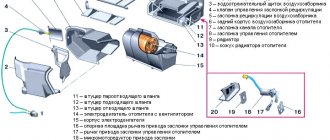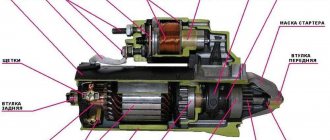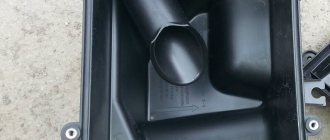Any internal combustion engine requires proper cooling. Without it, the motor will simply overheat, as a result of which the moving elements will instantly fail. The engines of modern cars are equipped with a liquid cooling system, which provides for constant circulation of coolant (coolant), achieved through the operation of a water pump (pump). Whatever coolant is used in the engine, prolonged heating will invariably lead to boiling. To prevent this process, a radiator is used in the cooling system. It is a system of thin tubes equipped with special lamellas that increase the area of the cooler.
When the car is in motion, the air flow hits the working surface of the radiator and passes between the lamellas, cooling the metal. Thus, the coolant temperature gradually decreases.
However, the radiator is not able to cope with overheating on its own, especially if the car is stationary or moving at low speeds. He is helped in this by an electric fan, which turns on automatically when the coolant reaches a certain temperature.
If it fails, the engine inevitably faces overheating with all the ensuing consequences. In this article, we will talk about possible reasons why the cooling fan does not turn on, as well as how to identify and resolve the related problems.
What is a radiator fan
To begin with, let us note that all the information provided is more intended for VAZ owners, although it can also be useful for drivers of foreign cars.
The VAZ cooling fan is an ordinary electric motor powered by 12 V from the vehicle’s on-board network. Its shaft is equipped with an impeller that generates a powerful air flow and directs it to the working surface of the radiator. The fan is mounted on a special frame (frame) to the front part. At the rear it is protected by a radiator grille.
Most VAZ cars are equipped with one fan. But there are also exceptions. For example, the NIVA cooling fan has two independent electric motors with an impeller that turn on simultaneously. This is necessary so that the engine of a domestic SUV cools faster.
How does the fan turn on?
The device turns on differently in different models. In cars with carburetor engines, it starts after the coolant reaches a certain temperature (105-107 0C) and the fan switch (not to be confused with the coolant temperature sensor), which sends a signal to the relay, is triggered. It closes the electrical circuit, supplying power to the electric motor.
The cooling fan circuit for cars with an injector is slightly different. Everything here is controlled by an electronic unit. Information from the switch-on sensor is first analyzed by the controller, and only then transmitted to the relay.
Where is the fan relay located on the VAZ 2114
There are 2 relays installed in a VAZ 2114 car. The first is located in the main mounting block, which is located in the engine compartment. Fuse F5 with a current of 20A, in addition to the sound signal, is connected to the fan relay.
The figure shows a new type of mounting block. On the cover there is a clear electrical diagram of the unit. There are symbols next to each device. The letters K indicate relays, the letters F indicate fuses. The device that protects the engine cooling fan is marked with the letter F5. This fuse is located in the right row, third from top to bottom.
There is one small nuance. In cars of the Samara family there are 2 types of mounting blocks. Below is a diagram of the old mounting block:
To open the mounting block to replace a blown fuse, you must release the two latches holding the cover in place and remove it. A special clothespin is attached to the box of the unit, which can be used to safely remove the fusible protective device. A blown fuse will be indicated by a silent beep, since this protective device also supports its operation.
The engine cooling fan relay on the VAZ 2114 is located in a small relay and fuse box in the passenger compartment under the dashboard on the passenger seat side. To get to this block, you need to unscrew the screws and move the partition.
This block has a built-in ignition relay, which is called the main one. The second is the cooling fan relay and the third is the fuel pump relay. Moreover, if the main relay has a constant location, the next 2 relays, depending on the assembly diagram of the electrical circuit, change places. More precisely, in some cars they are second, in others they are third. A fuse is built into each switching device. Their location also depends on the assembly scheme. Therefore, the required relay should be found using symbols. The figure offers 2 assembly options.
And now that you know where the cooling fan relay is located on the VAZ 2114, you can always check its operation, remove it if necessary and replace it with a new one. The fact is that four-pin relays, like fuses, are not repairable. They can only be replaced. They are relatively inexpensive - in the range of 100-200 rubles.
Possible fan malfunctions
If the fluid temperature has reached a critical value, but the radiator cooling fan does not work, it means that there is a problem somewhere. Our task is to find it and eliminate it. Let us indicate the most common malfunctions due to which the cooling fan does not work. There aren't that many of them.
- The fan motor has failed.
- The integrity of the wiring supplying the electric motor or connecting the fan switch sensor is damaged.
- Poor contact in the motor or sensor connectors.
- The cooling fan fuse has blown.
- The fan relay is faulty.
- The sensor is faulty.
- Malfunctions in the operation of the safety valve of the expansion tank.
Checking the electric motor
If the cooling fan does not work, the first thing you need to do is check its drive (electric motor). It's easy to do. It is enough to take two wires, connect them to the fan and power it directly from the battery. If it starts, then the problem is not with it. We need to look for it further. At the same time, you can check the contacts in the motor connector. Sometimes it happens that the problem is in them. The ingress of dirt and dust, as well as oxidation of metal surfaces can cause contact failure.
If the electric motor does not turn on after connecting to the battery, most likely it is the battery that has broken down. The reason for this may be:
- worn brushes;
- reservoir destruction;
- short circuit of the rotor or armature windings.
In the first case, it is enough to replace the brushes with new ones, and the fan motor will work like new again. In the case of destruction of the commutator or short circuit of the windings, repair may not help.
Checking the fuse and fan relay
If everything is in order with the electrical wiring, we move on to other equipment. First, let's check the cooling fan fuse. It is usually located in the mounting block under the hood of the car and is marked F7. We check it with the same car tester. If the fuse is good, move on. We are looking for the fan switch relay. It is located under the cover of the right panel of the center console. There are three relays located there. The car owner's manual will help you determine what you need, since different models have different locations.
But how to check the relay? In field conditions, it is almost impossible to determine its performance. It’s easier to take an adjacent relay (if its parameters match) and install it in the desired slot.
Where is the fan relay located on the VAZ 2114 (connection diagram, testing methods)
The question of where the cooling fan relay is located on a VAZ 2114 confuses many car owners. Those who like to tinker under the hood of their own vehicle believe that if there is a fuse in the mounting block, then it must correspond to a contact relay. But, as it turns out, this cooling device has two fuses, and both of them are located in different parts of the car. In this article, the reader will learn how to find the fan relay, where its first and second fuses are located, for what reasons the engine cooling device does not work, how to troubleshoot some problems in its electrical circuit, and in the cooling mechanism itself.
Testing the fan switch sensor
The next reason why the cooling fan does not work may be a faulty sensor. Cases of failure of this element are not so rare. It is possible to accurately determine that it is the sensor that has broken down only in a car with an injection engine. If you disconnect it from the power supply, the electronic control unit will perceive this as a system malfunction and start the fan in emergency mode.
The check is carried out as follows. We warm up the car until the coolant temperature reaches 100 0C, then turn off the engine, lift the hood and disconnect the sensor by disconnecting the connector on it. After this, we start the engine. If the fan turns on, then the problem is with the sensor.
Unfortunately, such a check is not possible in cars with carburetor engines. Here, you can determine the functionality of the fan switch sensor only by replacing it with a new one and warming up the engine to operating temperature.
Some troubleshooting methods
- If you think the cooling fan is not working and your temperature gauge indicates overheating, open the hood, start the engine, and let it idle for 15 to 20 minutes. If it turns on, you may have a faulty temperature sensor. 2.The cooling fan temperature switch (or sensor in some cars) can also get stuck, which can cause it to constantly run any time you turn the ignition key or start the engine. Troubleshoot the switch.
3. The reason the radiator fan does not turn on is that on some modern vehicles, the ambient air temperature sensor, vehicle speed sensor and other sensors may provide input to the car computer to determine the operation of the radiator fan. Consult your vehicle's repair manual to check the required sensors and switches.
Warning
When the engine is warm, the fan may turn on even if the engine is not running. When working on a hot or running engine, keep your hands and tools away from blades and moving components.
Changing the safety valve
There is another malfunction that can lead to system failure. If the cooling fan does not work even after confirming the operability of all the listed elements of the chain, it is worth checking the safety valve on the expansion tank.
The role of this valve is to maintain the operating pressure in the system above atmospheric pressure. This is necessary so that the water included in the coolant does not boil when heated to 100 0C. If the safety valve fails, the pressure in the system will equalize with atmospheric pressure and the liquid will boil, reaching the boiling point of water.
The switch-on sensor, as already mentioned, can only turn on at 105-107 0C. Thus, our coolant will boil, but the fan will not work.
How to check the safety valve? This is impossible at home. It’s easier to buy a new valve, especially since it costs pennies.
Useful tips
Finally, check out these useful tips that will allow you, if not to avoid problems with turning on the cooling fan in a timely manner, then at least to correct the situation a little.
- Systematically check the operation of all elements of the cooling system. Pay attention to the coolant temperature indicators on the instrument panel, and also listen to whether the fan turns on.
- Monitor the coolant level in the system. Replace it in a timely manner.
- At least once a year, wash the expansion tank cap under running water. This solution will extend the life of the safety valve.
- If there is the slightest malfunction in the cooling system, stop driving and take corrective action.
- If the cooling fan does not work due to a sensor, fuse or relay failure, and this malfunction caught you on the road, disconnect the sensor (for an injector) or connect the electric drive directly to the on-board network (for a carburetor). This way you can drive to the nearest service station without the risk of engine overheating.
Why doesn't it work
There are several reasons why the propeller may not turn on when the temperature situation requires it:
- The electric motor of the fan, that is, the drive, has failed;
- The fuse broke and burned out;
- Relay failed;
- The wiring is broken;
- The sensor connectors have lost contact;
- The sensor has failed.
Finding the fault
| Problem search area | Explanation |
| Propeller check | The connector on the propeller is disconnected and connected directly to the battery. If the fan starts working, everything is fine with the drive. If the propeller still does not spin, the problem is in the electric motor. |
| Wiring and contacts | If the propeller does not work, you must check the condition of the wiring and make sure that the sensor contacts are working properly |
| Fuse | You can find these two elements in the engine compartment on the left, closer to the driver, inside the mounting block. The fan is supplied with a fuse designated F4 with a rated current of 20A. The test can be performed by pressing the horn button. Why? Yes, because it is also connected to this fuse. Or check with a tester |
| Relay | It is located in the same place as the fuse. For an effective test, it is best to take a relay that you are 100% sure is working!, install it in place of the old one and check |
| Sensor | To test the sensor, disconnect power from it. If it works, the propeller will start working in emergency mode, that is, it will blow constantly. Disconnect the connector and turn on the ignition. If the propeller spins, then the sensor is broken. Need replacement |
When to change
If the fan itself is the cause of all the problems, it is not necessary to change it, since in some cases it can be repaired. Failures are often associated with bearings or brushes.
If the cause of the breakdown is the failure of the electric motor due to a broken wiring or short circuit, it is not worth the risk of repairing it. It is easier and better to replace the entire drive.
Checking for open circuit
If you drive a car that does not have a cooling propeller, this will lead to overheating of the coolant and destruction of pipes, rubber elements, gaskets of the main cylinder block and valve covers. It is not far from destroying the components of the piston group.
Fuse
Operating a vehicle with a broken fan is strictly prohibited.
Price issue
Before starting to solve the problem of a radiator propeller not working, it is important for many people to learn about the cost of components and labor.
A new element today will cost approximately 1.5-2.5 thousand rubles, depending on the model and region. The cost of replacement at a service station will be from 400 rubles and more. Although it is not necessary to spend money on this, since replacing it yourself will take you no more than half an hour. Yes, and there is nothing particularly complicated here.
temperature sensor











